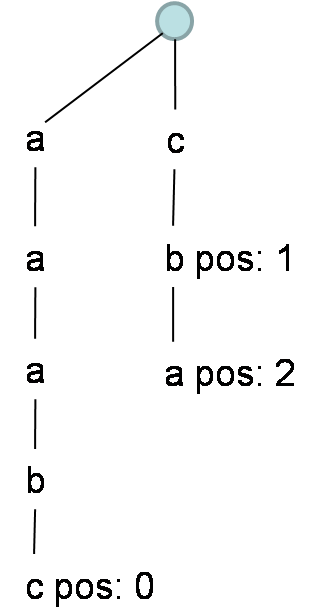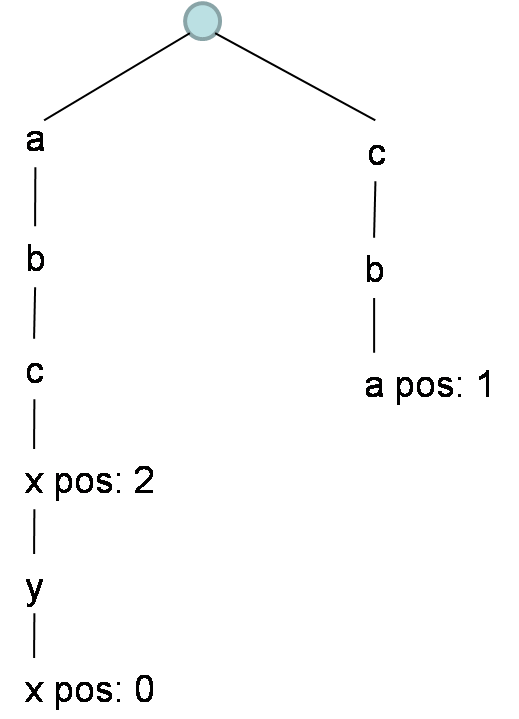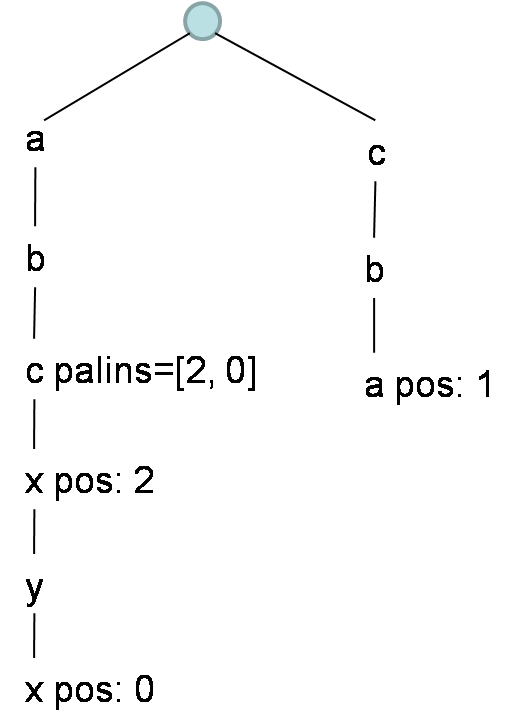Leetcode 336. Given a list of unique words. Find all pairs of distinct indices (i, j) in the given list, so that the concatenation of the two words, i.e. words[i] + words[j] is a palindrome.
Example 1:
Given words = ["bat", "tab", "cat"]
Return [[0, 1], [1, 0]]
The palindromes are ["battab", "tabbat"]
Example 2:
Given words = ["abcd", "dcba", "lls", "s", "sssll"]
Return [[0, 1], [1, 0], [3, 2], [2, 4]]
The palindromes are ["dcbaabcd", "abcddcba", "slls", "llssssll"]
Solution. The solution is from here. We uses trie. For each string, we save it trie in reverse order. For example, if it is abc. The trie will be like below. a has value pos. This tells that trie cba is a word.
![]()
When we use cbaxyx to match the trie, it will finally goes to trie a. And when it sees a has pos, we check if xyx is a palindrome. If it is, then we know cbaxyx and abc is a pair of palindrome.
Think about words[] = {“cbaaa”, “bc”, “abc”}. The trie will be like:

When it tries to match cbaaa, when it arrives cb, its pos is 1, then we should check if aaa is a palindrome. When it arrives cba, we should check if rest of string aa is a palindrome. In this way, we can know that [“cbaaa”, “bc”], [“cbaaa”, “abc”] are pairs.
How about [“xyxcba”, “abc”, “xcba”]?

When we check abc and it arrives c in trie. We should know that the rest of string after abc has palindrome. So we modify trie like this:

c has a list palins. It tells string below c, what rest of word is palindrome. When we scan abc, it will finally stops at c in xyxabc. When it ends, check if palins list of trie c is not empty. If not, it may be able to concatenate into palindrome.
We can do it in another way by rolling hash which I wrote a post before. But the code is too much overhead.
Below is my code:
public static class Trie {
int pos;
Trie[] nodes; // consider xyxabc. if current trie is 'a'. Then a.nodes has information. It means string after a is palindrome
List<Integer> palins;
public Trie() {
pos = -1;
nodes = new Trie[26];
palins = new ArrayList<>();
}
}
public static void add(Trie root, String word, int pos) {
for (int i = word.length() - 1; i >= 0; i--) {
char ch = word.charAt(i);
if (isPalindrome(word, 0, i)) { // check if substring(0, i) is palindrome.
root.palins.add(pos);
}
if (root.nodes[ch - 'a'] == null) {
root.nodes[ch - 'a'] = new Trie();
}
root = root.nodes[ch - 'a'];
}
root.pos = pos; // if it is xyxcba. Until now, the node should be at x.
root.palins.add(pos);
}
public static void search(Trie root, String[] words, int i, List<List<Integer>> ans) {
int len = words[i].length();
for (int j = 0; j < len && root != null; j++) {
if (root.pos >= 0 && i != root.pos && isPalindrome(words[i], j, len - 1)) {
ans.add(Arrays.asList(new Integer[] {i, root.pos}));
}
char ch = words[i].charAt(j);
root = root.nodes[ch - 'a'];
}
if (root != null && root.palins.size() > 0) { // assume 'xyxabc' is in trie, now try 'cba'
for (int j : root.palins) {
if (j != i) {
ans.add(Arrays.asList(new Integer[] {i, j}));
}
}
}
}
public static List<List<Integer>> palindromePairs(String[] words) {
List<List<Integer>> ans = new ArrayList<>();
Trie trie = new Trie();
for (int i = 0; i < words.length; i++) {
add(trie, words[i], i);
}
for (int i = 0; i < words.length; i++) {
search(trie, words, i, ans);
}
return ans;
}
public static boolean isPalindrome(String str, int i, int j) {
while (i < j) {
if (str.charAt(i++) != str.charAt(j--)) {
return false;
}
}
return true;
}
Check my code on github.
Pingback: Palindromic pairs in an array of words - Tutorial Guruji()